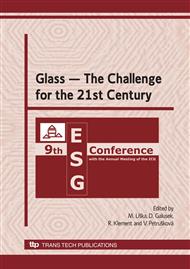p.607
p.613
p.619
p.625
p.633
p.641
p.647
p.653
p.659
Nuclear Waste Glasses: Continuous Melting and Bulk Vitrification
Abstract:
This contribution addresses various aspects of nuclear waste vitrification. Nuclear wastes have a variety of components and composition ranges. For each waste composition, the glass must be formulated to possess acceptable processing and product behavior defined in terms of physical and chemical properties that guarantee that the glass can be easily made and resist environmental degradation. Glass formulation is facilitated by developing property-composition models, and the strategy of model development and application is reviewed. However, the large variability of waste compositions presents numerous additional challenges: insoluble solids and molten salts may segregate; foam may hinder heat transfer and slow down the process; molten salts may accumulate in container refractory walls; on cooling, the glass may precipitate crystalline phases. These problems need targeted exploratory research. Examples of specific problems and their possible solutions are discussed.
Info:
Periodical:
Pages:
633-640
Citation:
Online since:
April 2008
Authors:
Keywords:
Price:
Сopyright:
© 2008 Trans Tech Publications Ltd. All Rights Reserved
Share:
Citation:


